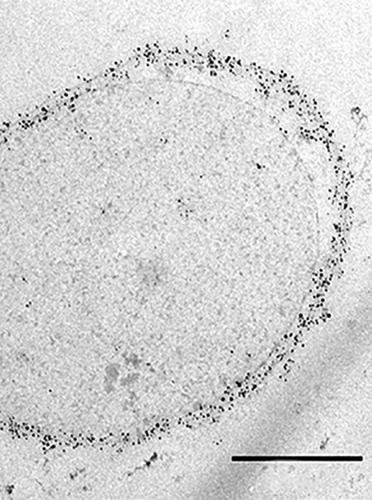当前位置:
X-MOL 学术
›
Microsc. Res. Tech.
›
论文详情
Our official English website, www.x-mol.net, welcomes your feedback! (Note: you will need to create a separate account there.)
2D and 3D immunogold localization on (epoxy) ultrathin sections with and without osmium tetroxide.
Microscopy Research and Technique ( IF 2.5 ) Pub Date : 2020-02-14 , DOI: 10.1002/jemt.23459 Jennifer Flechsler 1 , Thomas Heimerl 2 , Carolin Pickl 1 , Reinhard Rachel 3 , York-Dieter Stierhof 4 , Andreas Klingl 1
Microscopy Research and Technique ( IF 2.5 ) Pub Date : 2020-02-14 , DOI: 10.1002/jemt.23459 Jennifer Flechsler 1 , Thomas Heimerl 2 , Carolin Pickl 1 , Reinhard Rachel 3 , York-Dieter Stierhof 4 , Andreas Klingl 1
Affiliation

|
For nearly 50 years immunogold labeling on ultrathin sections has been successfully used for protein localization in laboratories worldwide. In theory and in practice, this method has undergone continual improvement over time. In this study, we carefully analyzed circulating protocols for postembedding labeling to find out if they are still valid under modern laboratory conditions, and in addition, we tested unconventional protocols. For this, we investigated immunolabeling of Epon‐embedded cells, immunolabeling of cells treated with osmium, and the binding behavior of differently sized gold particles. Here we show that (in contrast to widespread belief) immunolabeling of Epon‐embedded cells and of cells treated with osmium tetroxide is actually working. Furthermore, we established a “speed protocol” for immunolabeling by reducing antibody incubation times. Finally, we present our results on three‐dimensional immunogold labeling.
中文翻译:

在有和没有四氧化的情况下(环氧树脂)超薄切片上的2D和3D免疫金定位。
近50年来,超薄切片上的免疫金标记已成功用于全球实验室的蛋白质定位。从理论上和实践上,这种方法都随着时间的推移不断改进。在这项研究中,我们仔细分析了用于嵌入后标记的循环方案,以了解它们在现代实验室条件下是否仍然有效,此外,我们还测试了非常规方案。为此,我们研究了Epon包埋细胞的免疫标记,处理细胞的免疫标记以及不同大小的金颗粒的结合行为。在这里,我们表明(与普遍的看法相反),Epon包埋的细胞和四氧化with处理过的细胞的免疫标记实际上是有效的。此外,我们通过减少抗体的孵育时间为免疫标记建立了“快速方案”。最后,我们介绍了三维免疫金标记的结果。
更新日期:2020-02-14
中文翻译:

在有和没有四氧化的情况下(环氧树脂)超薄切片上的2D和3D免疫金定位。
近50年来,超薄切片上的免疫金标记已成功用于全球实验室的蛋白质定位。从理论上和实践上,这种方法都随着时间的推移不断改进。在这项研究中,我们仔细分析了用于嵌入后标记的循环方案,以了解它们在现代实验室条件下是否仍然有效,此外,我们还测试了非常规方案。为此,我们研究了Epon包埋细胞的免疫标记,处理细胞的免疫标记以及不同大小的金颗粒的结合行为。在这里,我们表明(与普遍的看法相反),Epon包埋的细胞和四氧化with处理过的细胞的免疫标记实际上是有效的。此外,我们通过减少抗体的孵育时间为免疫标记建立了“快速方案”。最后,我们介绍了三维免疫金标记的结果。



























 京公网安备 11010802027423号
京公网安备 11010802027423号